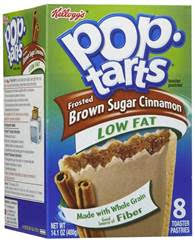 You’re walking through the grocery store, perusing the shelves in search of ideas for a nutritious snack choice to keep at your desk during the workday. The choices are virtually endless, and the terms “healthy”, “organic”, “low-fat”, and “gluten-free” are everywhere. If a food has one or more of these labels, it has to be a good choice, right?
You’re walking through the grocery store, perusing the shelves in search of ideas for a nutritious snack choice to keep at your desk during the workday. The choices are virtually endless, and the terms “healthy”, “organic”, “low-fat”, and “gluten-free” are everywhere. If a food has one or more of these labels, it has to be a good choice, right?
These terms are often used in food marketing to influence our perception of the health value of various food items. The term “health halo” refers to the act of overestimating the healthfulness of an item based on a single claim. If we see a product is “low-fat” or “organic”, for example, we are more likely to trust the other health components of the product. We are also more likely to eat more of the item, in the belief that it is nutritious. An organic cookie and a regular cookie are going to be very similar nutritionally. Yet many consumers will feel better (and eat more) when they buy the organic variety.
Health halos can also apply to companies or food chains. Take Subway for example. Subway’s slogan (“Eat Fresh”) and reputation for nutritious options can create a health halo for consumers eating there. One study found that consumers who felt better about choosing a healthy meal at Subway (as opposed to other fast-food chains) also ordered more sides, drinks, and desserts than other consumers. Oftentimes salads are given a health halo by consumers, regardless of what the components and portions of the salads are like.
Another example is making food choices after a workout. It’s true that your body needs additional nutrients to get the most out of a strenuous exercise session. The problem is that many people overestimate how much “extra” is actually needed. They also might dismiss the quality of those choices due to having exercised. Basically, a health halo might be placed on foods eaten after workouts.
Being a critical and knowledgeable consumer means understanding that just because a food is labeled a certain way does not guarantee it to be nutritious. There are many nutritious foods that have gluten and fat in them, and there are many foods labeled as “healthy” that wouldn’t be able to defend that claim in court. If you’re trying to improve your choices, buy the majority of your foods from the perimeter of the grocery store (rather than the aisles in the middle) and spend more time in the produce section than you do in other areas of the store.
